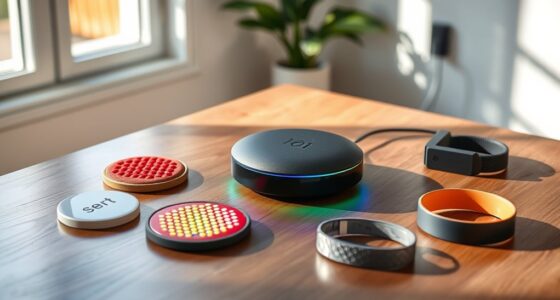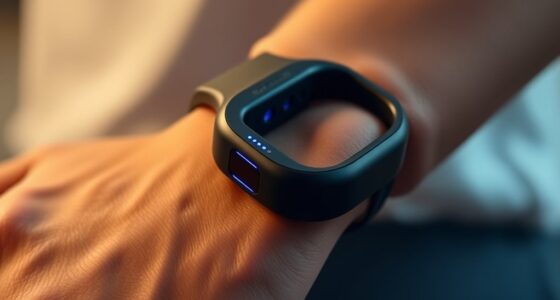Deaf-friendly smart homes combine visual signals, vibratory alerts, and IoT devices to guarantee safety and effective communication. You can use flashlights, colored lights, and vibrating devices to get quick alerts for alarms or social signals. IoT platforms connect these devices seamlessly, allowing you to customize and automate responses. If you explore further, you’ll discover how these innovative systems create a safer, more inclusive living environment tailored to your needs.
Key Takeaways
- Integrate visual alerts like flashing lights and visual signage with IoT systems for real-time, inclusive notifications.
- Use vibratory devices and wearables to deliver discreet, personalized alerts for emergencies and social cues.
- Strategically place sensors and vibration devices in high-traffic or sleeping areas for effective alert reception.
- Combine multiple alert types—visual, vibratory, auditory—for a comprehensive, safety-enhancing smart home environment.
- Leverage IoT platforms and voice commands for seamless, automated control of alerts, increasing independence for deaf residents.
The Importance of Accessibility in Modern Living Spaces

Accessibility plays a crucial role in ensuring that modern living spaces are inclusive and functional for everyone. When designing a deaf-friendly home, you prioritize features like sign language interpretation, which allows clear communication without barriers. Accessible kitchen designs also make daily tasks easier, integrating features like visual alerts and voice-activated appliances. These adaptations create a space where deaf residents can navigate comfortably and independently. Incorporating such elements not only enhances safety but also promotes equality, making sure no one feels left out. By focusing on accessible layouts and communication tools, you foster an environment that truly accommodates diverse needs. Additionally, integrating vibrational alerts can further improve safety and awareness for deaf residents. Embracing multi-sensory communication features can significantly enhance the living experience for individuals with hearing impairments. A well-designed space considers inclusive design principles that address a variety of sensory and mobility needs. Incorporating elements like visual signage can also improve navigation and clarity within the home. For example, understanding how to implement IoT alert systems effectively ensures timely notifications for safety and daily activities. Ultimately, accessibility isn’t just a feature—it’s the foundation for a safe, inclusive, and empowering living space for all.
Types of Visual Alert Systems for Deaf Residents
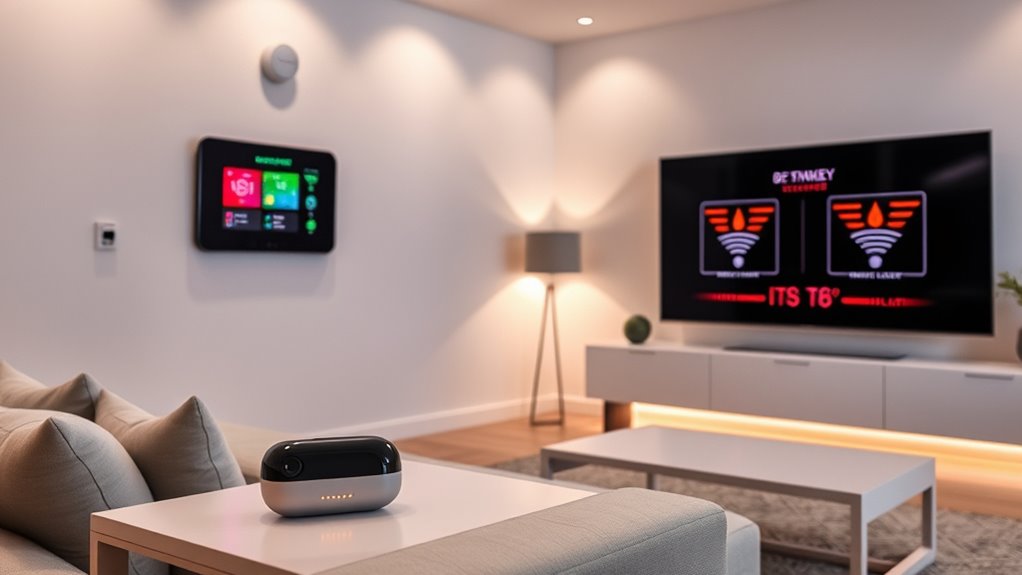
Visual alert systems are essential tools that help deaf residents stay aware of their surroundings by providing immediate, non-verbal cues. These systems vary in design, allowing you to customize visual alerts to suit your preferences, such as flashing lights or color-coded signals. One key feature is visual alert customization, enabling you to tailor notifications for specific alerts like doorbells, phone calls, or fire alarms. Emergency notification systems are integrated to ensure you’re instantly informed during critical situations, often using bright flashing lights or visual indicators throughout your home. You can choose from standalone devices or smart home integrations that synchronize alerts across multiple rooms. These visual alert systems empower you to respond quickly and confidently, creating a safer, more accessible living environment. Additionally, integrating retail hours can help you plan when to purchase or service these alert systems effectively. Incorporating cost-effective options can make these safety features more accessible without compromising quality. To maximize their effectiveness, consider user-friendly interfaces that enhance ease of use for all residents, and staying informed about the latest home automation advancements can further enhance your deaf-friendly smart home. Moreover, understanding the 16PF personality traits can assist in customizing alert systems that better suit individual preferences and responses.
Incorporating Vibratory Notifications for Enhanced Safety
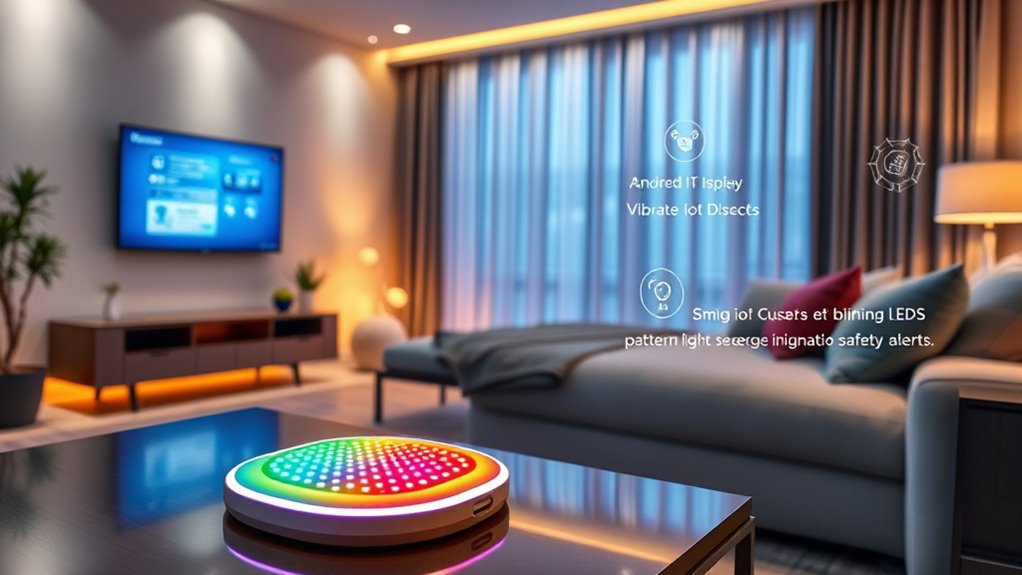
Vibratory notifications can ensure safety in a smart home by providing discreet alerts during emergencies. You should consider different types of vibration devices and strategic placement to ensure you feel alerts promptly. Integrating vibratory alerts with visual and auditory systems creates a thorough safety network tailored to your needs.
Types of Vibratory Alerts
Have you ever wondered how vibratory alerts can improve safety in smart homes for the deaf? Different vibratory patterns serve various functions, such as distinguishing between alarms or alerts. For example, short, rapid vibrations might signal a fire alarm, while slow, steady patterns could indicate doorbell notifications. Wearable alert devices are versatile tools that deliver these vibrations directly to your body, ensuring you notice important alerts even if you’re away from visual or auditory cues. These devices can be customized to suit your preferences, making alerts more effective and less intrusive. By utilizing a range of vibratory patterns, smart homes can provide clear, immediate notifications tailored to individual needs, enhancing safety and independence for deaf residents. Incorporating durable, safe materials into these devices ensures they withstand everyday use and maintain reliable performance over time. Additionally, understanding vibratory notification patterns can improve how residents interpret different alerts, leading to quicker responses and greater peace of mind. Recognizing the importance of assistive technology helps in designing more effective and inclusive safety systems for all users. Incorporating user-centered design principles can further optimize the effectiveness and comfort of vibratory alert devices. Moreover, integrating features such as smart IoT alerts allows for seamless communication between devices, increasing overall safety and responsiveness.
Placement Strategies for Vibration Devices
To guarantee vibratory alerts effectively capture your attention, strategic placement of vibration devices is essential. Proper vibration device placement ensures notifications reach you promptly during emergencies or daily alerts. You should position vibration devices near your bed, sofa, or high-traffic areas where you spend most of your time. Consider sensor positioning carefully; sensors should be installed in locations that detect specific events, like door openings or smoke alarms, and transmit signals efficiently. Avoid placing devices behind furniture or in corners where vibrations might dampen. Regularly test and adjust vibration device placement to optimize alert visibility and responsiveness. Thoughtful sensor positioning guarantees alerts are accurate, reliable, and timely, providing you with enhanced safety and peace of mind in your smart home environment. Additionally, understanding the self-watering system can help you ensure your home remains comfortable and well-maintained. Incorporating security measures tailored for IoT devices can further protect your smart home from cyber threats. Proper placement of vibration devices also considers potential interference from other electronic devices, ensuring consistent alert delivery. For example, integrating knowledge about Bike gear-shifting techniques can inspire better placement strategies for devices, ensuring they are accessible and easy to operate during critical moments. Moreover, choosing the right earbuds can improve alert reception, especially for users with small ears or specific needs.
Integration With Other Alerts
Integrating vibratory notifications with other alert systems creates a thorough safety network within your smart home. This setup guarantees you receive timely emergency communication through multiple channels, such as lights and vibrations, reducing the risk of missing essential alerts. By combining vibratory alerts with visual signals, you can quickly identify emergencies like fire alarms or doorbells, even if you’re not looking directly at a device. Additionally, this integration supports social interaction, allowing you to stay connected with visitors or family members through synchronized alerts. You can customize notifications to suit your preferences, ensuring safety and communication are seamless. Overall, combining vibratory notifications with other alerts enhances your independence and confidence in managing safety and social cues within your smart home environment. Incorporating holistic health awareness into your daily routines can also promote a sense of calm and resilience during emergencies, supporting overall well-being.
Smart Home Devices That Connect With Iot Platforms
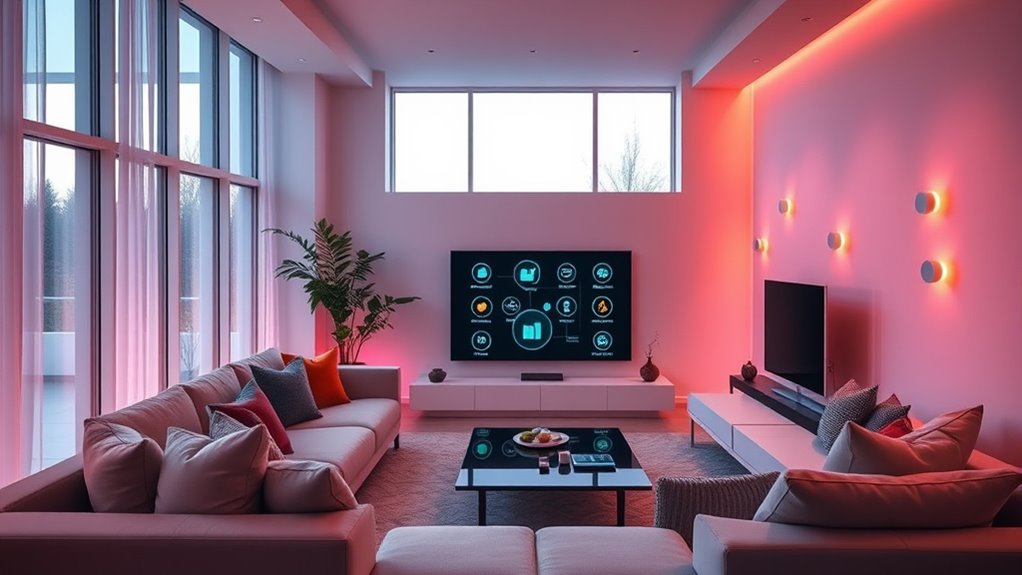
Smart home devices that connect with IoT platforms enable seamless communication and control across your entire home, making it easier to customize and automate your environment. With wearable sensors, you can monitor essential signs or movement, feeding data directly into your smart system for personalized alerts. IoT integration allows these devices to respond instantly to voice commands, giving you hands-free control over lights, vibrations, and alerts. You can set routines that activate lights or vibrations based on sensor data or specific voice prompts, creating a deaf-friendly environment. This connectivity empowers you to streamline your home’s automation, ensuring that alerts are not only effective but also tailored to your needs, enhancing safety and independence within your smart home setup. Additionally, predictive analytics can help anticipate your needs and adjust settings proactively, further improving your smart home experience. Incorporating IoT platforms that support various smart devices ensures compatibility and smoother operation across different brands and technologies. Integrating interoperability standards can further enhance device compatibility and system reliability, while home automation systems can provide centralized control for all connected devices. Moreover, understanding the best juice cleanses for weight loss can support overall wellness, complementing a healthy lifestyle that benefits your energy and vitality.
Designing a Seamless Integration of Alerts and Home Automation

Building on the connectivity of IoT-enabled devices, designing a seamless integration of alerts and home automation guarantees your smart home responds intuitively to your needs. You can use gesture control to activate lights or vibrations instantly, ensuring quick, discreet alerts. Voice command allows you to manage routines effortlessly, like adjusting lighting or setting vibrations for specific alerts. Integrate these controls into a unified system so that alerts trigger appropriate responses automatically, whether it’s flashing lights when a door opens or vibrating alerts for important messages. By designing with interoperability in mind, you guarantee your smart home functions smoothly without manual intervention. This seamless setup creates an environment where alerts and automation work together naturally, enhancing safety and independence for deaf users.
Choosing the Right Technologies for a Customized Experience
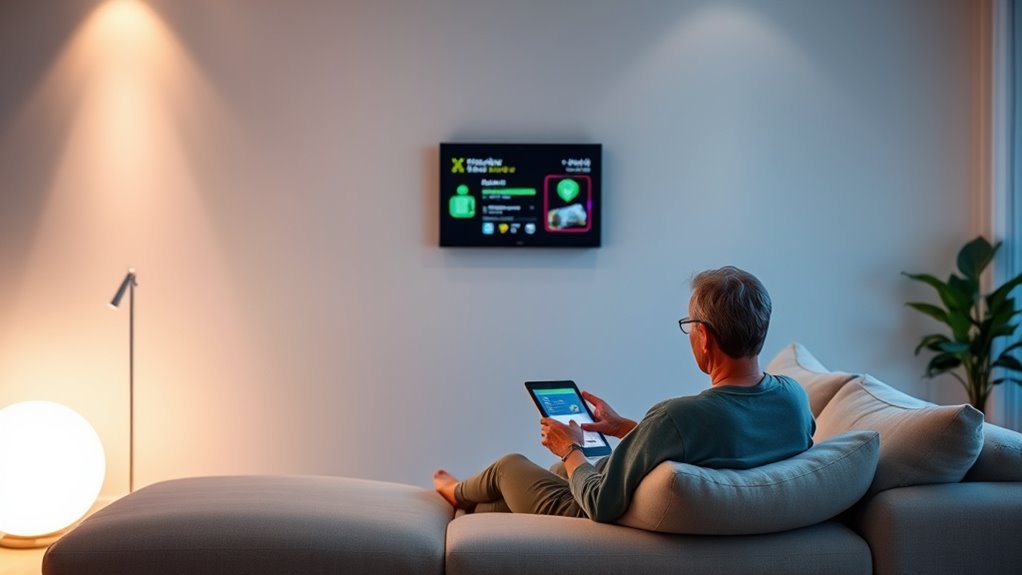
Choosing the right technologies is essential to creating a customized smart home experience that truly meets your needs. You should explore wearable technology that offers seamless alerts, like vibrating wristbands or glasses, to guarantee you never miss important notifications. These devices can be tailored to your preferences, providing discreet and immediate alerts. Additionally, customizable interfaces allow you to adjust settings easily, so alerts and controls suit your daily routine. Look for platforms that integrate well with your existing devices and support personalized options, making it simple to create a system that responds to your specific needs. By selecting adaptable and user-friendly technologies, you’ll build a deaf-friendly environment that enhances safety, independence, and comfort.
Future Trends in Deaf-Friendly Smart Home Innovations

Advancements in technology are paving the way for even more innovative solutions that enhance accessibility for deaf individuals. Future smart home innovations will likely feature advanced voice command systems that require minimal effort, allowing you to control devices effortlessly through natural speech. These systems will become more intuitive, learning your preferences over time to streamline daily routines. Additionally, energy efficiency will play a bigger role, with smart appliances optimizing power use to reduce costs and environmental impact. Integrated AI will enable your home to adapt dynamically, providing real-time alerts through vibrations, lights, and visual cues. As these trends develop, your smart home will become more responsive, inclusive, and sustainable, ensuring a seamless living experience tailored specifically to your needs.
Frequently Asked Questions
How Do Smart Homes Adapt for Varying Degrees of Hearing Loss?
You can make your smart home adapt to varying degrees of hearing loss by using customizable alerts like flashing lights, vibration signals, and visual indicators. These features help with visual impairment and mobility assistance, ensuring you don’t miss important notifications. Smart systems can be tailored to your needs, providing a seamless experience that enhances safety and independence while addressing different levels of hearing impairment.
Are Deaf-Friendly Alert Systems Compatible With All Smart Home Brands?
Think of deaf-friendly alert systems as universal remote controls—designed to work smoothly across different smart home brands. While many systems aim for broad compatibility, some may face limitations due to brand-specific protocols or integrations. Always check for universal compatibility and brand integration options before purchasing. This way, you can guarantee your alert system seamlessly connects with your smart home devices, offering reliable alerts tailored to your needs.
What Privacy Concerns Arise With Iot Alert Integrations in Smart Homes?
With IoT alert integrations, you should be aware of privacy concerns like data breaches and unauthorized access. You need to guarantee your devices use strong data encryption to protect your information. Also, always give clear user consent for data collection and sharing. By staying informed and managing your privacy settings, you can enjoy the benefits of smart alerts without risking your personal data.
Can These Alert Systems Be Customized for Individual Sensory Preferences?
You can absolutely customize alert systems for your sensory preferences. Sensory customization allows you to personalize alerts through lights, vibrations, or other cues based on what works best for you. By tailoring these alerts, you guarantee they’re effective and comfortable, whether you prefer bright lights, gentle vibrations, or a combination. Personalization makes your smart home more accessible, catering to your unique needs and enhancing your overall safety and convenience.
How Cost-Effective Are Deaf-Friendly Smart Home Solutions Compared to Traditional Ones?
You’ll find that deaf-friendly smart home solutions often have a favorable cost comparison to traditional systems. While initial investments might seem higher, the affordability analysis shows long-term savings through energy efficiency and reduced reliance on costly emergency services. Plus, customizable alerts enhance safety and convenience. Overall, these solutions are increasingly affordable, making them a practical choice for improving quality of life without breaking the bank.
Conclusion
By integrating lights, vibrations, and IoT alerts, you create a safer, more inclusive home for deaf residents. Did you know that about 15% of the world’s population experiences some form of hearing loss? Embracing smart technology not only enhances safety but also promotes independence and peace of mind. As these innovations evolve, you’ll find more personalized ways to make your living space truly accessible for everyone.





